Symbotic Bundle
How Did Symbotic Revolutionize Warehouse Automation?
Dive into the fascinating Symbotic SWOT Analysis to understand the company's journey! Founded in 2007, Symbotic Inc. has rapidly transformed the supply chain landscape. This innovative company leverages AI-powered robotics to optimize warehouse efficiency, offering groundbreaking solutions for businesses worldwide. Learn how Symbotic's vision became a reality.
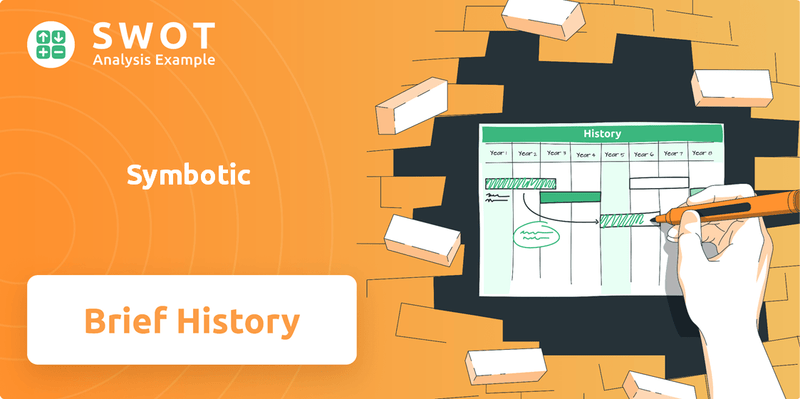
From its inception, the Symbotic company focused on providing cutting-edge warehouse automation solutions. Its Symbotic history is marked by significant technological advancements, including the development of high-speed autonomous robots. The company's impressive revenue growth, reaching $1.822 billion in fiscal year 2024, is a testament to its impact on the industry and its commitment to supply chain solutions.
What is the Symbotic Founding Story?
The story of Symbotic begins in 2007, with Rick Cohen at the helm as founder, Chairman, and Chief Executive Officer. The genesis of the Symbotic company is deeply intertwined with the wholesale grocery business owned by the Cohen family. This background provided the crucial insight that sparked the company's inception: a need for advanced warehouse automation solutions.
The lack of existing solutions led Cohen to build a system from scratch. The first prototype was a humble beginning, built on a piece of plywood and four wheels. This initial phase set the stage for what would become a revolution in supply chain management.
Originally named CasePick Systems, the company later rebranded to Symbotic in January 2012. This change reflected the company's core focus on the symbiotic relationship between supply chain and robotics. The primary goal was to tackle the inefficiencies and high costs associated with traditional warehouse operations, particularly the manual handling of pallets and cases. The business model was built around developing and deploying end-to-end technology solutions.
Symbotic's history is marked by innovation and a clear vision to transform warehouse operations.
- Founded in 2007 by Rick Cohen.
- Initially named CasePick Systems, rebranded to Symbotic in 2012.
- Focused on automating warehouse operations to reduce costs and improve efficiency.
- Backed by Rick Cohen's background in the wholesale grocery business.
Symbotic SWOT Analysis
- Complete SWOT Breakdown
- Fully Customizable
- Editable in Excel & Word
- Professional Formatting
- Investor-Ready Format
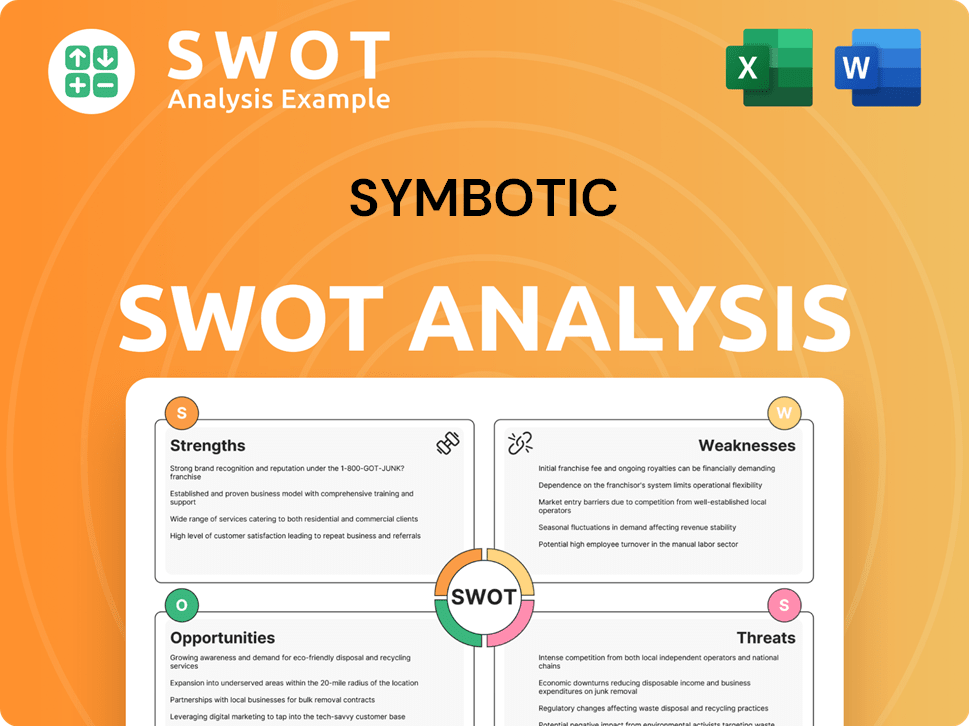
What Drove the Early Growth of Symbotic?
The early growth of the Symbotic company was marked by significant technological refinement and strategic partnerships. After developing its core technology as CasePick Solutions, Symbotic secured its first commercial contract. A key early adopter of Symbotic's technology was Target, which integrated the systems in 2014. This period laid the foundation for future expansion in the warehouse automation sector.
A pivotal collaboration began in 2017 with Walmart, deploying Symbotic's robotics in a distribution center in Brooksville, Florida. This partnership expanded to include 25 additional regional distribution centers by July 2021. The acquisition of Symbotic by C&S Wholesale Grocers in 2017 provided financial stability and a major client, facilitating the scaling of its technology for supply chain solutions.
Symbotic also initiated work with Albertsons in 2017, broadening its client base. Continuous investment in AI and machine learning software has been crucial to the evolution of its systems. This focus on Symbotic innovation positioned the company for its next phase, leading to its public listing in 2022 through a SPAC merger, which provided capital for further expansion of its AI-enabled automated warehouse systems.
Symbotic's revenue growth has been substantial, with fiscal year 2024 revenue reaching $1.822 billion, a 55% increase year-over-year. This growth trajectory underscores the increasing demand for its supply chain solutions benefits in the market. The company's ability to secure major partnerships and continuously innovate has been key to its success, positioning it well for future growth and further advancements in the Symbotic future.
The early adoption by Target and the subsequent partnership with Walmart highlighted the effectiveness of Symbotic automated storage and retrieval system. The SPAC merger in 2022 was a strategic move to fuel expansion, providing the necessary resources to scale operations and accelerate market penetration. These strategic initiatives have solidified Symbotic's position in the competitive landscape of Symbotic competitors.
Symbotic PESTLE Analysis
- Covers All 6 PESTLE Categories
- No Research Needed – Save Hours of Work
- Built by Experts, Trusted by Consultants
- Instant Download, Ready to Use
- 100% Editable, Fully Customizable
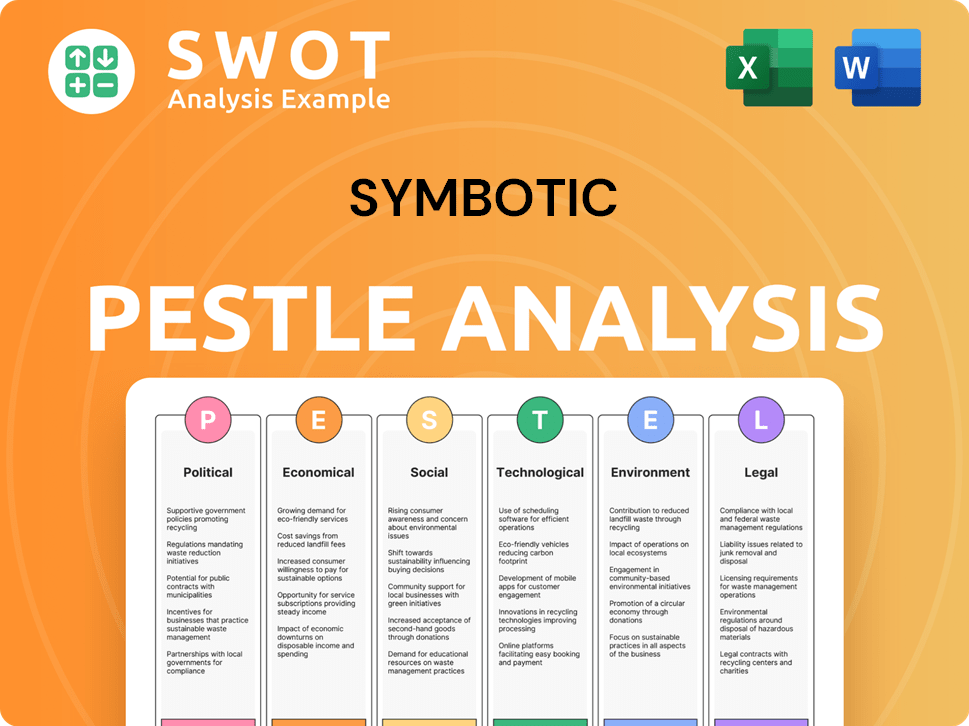
What are the key Milestones in Symbotic history?
The Symbotic company's journey is marked by key milestones, including the launch of its automated warehouse system and significant partnerships. The company's focus on warehouse automation and supply chain solutions has driven its growth and market position. This Symbotic history reflects its evolution and strategic decisions.
| Year | Milestone |
|---|---|
| Early 2000s | Symbotic was founded, marking the beginning of its journey in warehouse automation. |
| 2010s | The company began deploying its automated warehouse systems, focusing on efficiency and accuracy. |
| 2022 | Symbotic went public, marking a significant step in its corporate journey, with its IPO date. |
| 2024 | Expanded into the Mexican market through a partnership with Walmex, deploying systems in two new distribution centers. |
| January 2025 | Acquired Walmart's Advanced Systems and Robotics business, solidifying its partnership and expanding its reach. |
Symbotic consistently innovates to improve its warehouse automation technology. The development of the SymBot, an advanced autonomous robot, enhanced system capabilities. The company's investment in AI and machine learning software has been crucial for its Symbotic technology overview.
Symbotic utilizes advanced robotics to automate warehouse operations, improving efficiency and accuracy. This includes the development of autonomous robots like the SymBot, which enhances system capabilities.
The company heavily invests in AI and machine learning to optimize its software. These technologies help manage complex warehouse operations, improving decision-making and system performance.
Symbotic offers automated storage and retrieval systems. These systems are designed to enhance the speed and precision of warehouse operations.
The company focuses on optimizing supply chains through its automated solutions. This includes improving the flow of goods from suppliers to consumers.
Symbotic integrates its systems seamlessly into existing warehouse infrastructure. This approach minimizes disruption and maximizes efficiency gains for its clients.
Symbotic uses data analytics to improve its systems. This data-driven approach helps optimize operations, predict maintenance needs, and enhance overall performance.
Symbotic has faced challenges, including market competition and system deployment delays. The company also addressed revenue recognition errors, leading to a restatement of its FY2024 financial results. For more insights, explore the Marketing Strategy of Symbotic.
Symbotic operates in a competitive market with players like Amazon Robotics and Ocado. Staying ahead requires continuous innovation and strategic partnerships.
The company has experienced delays in system deployments. These delays can impact revenue recognition and customer satisfaction.
Symbotic has a significant reliance on Walmart for a large portion of its revenue. This concentration poses financial risks.
Global economic uncertainties can affect Symbotic's operations. These uncertainties can impact investment decisions and project timelines.
In late 2024, Symbotic announced a delay in its Form 10-K filing. This was due to errors in revenue recognition, which led to financial restatements.
Rapid technological advancements require constant innovation to stay competitive. This includes improvements in AI, robotics, and software.
Symbotic Business Model Canvas
- Complete 9-Block Business Model Canvas
- Effortlessly Communicate Your Business Strategy
- Investor-Ready BMC Format
- 100% Editable and Customizable
- Clear and Structured Layout
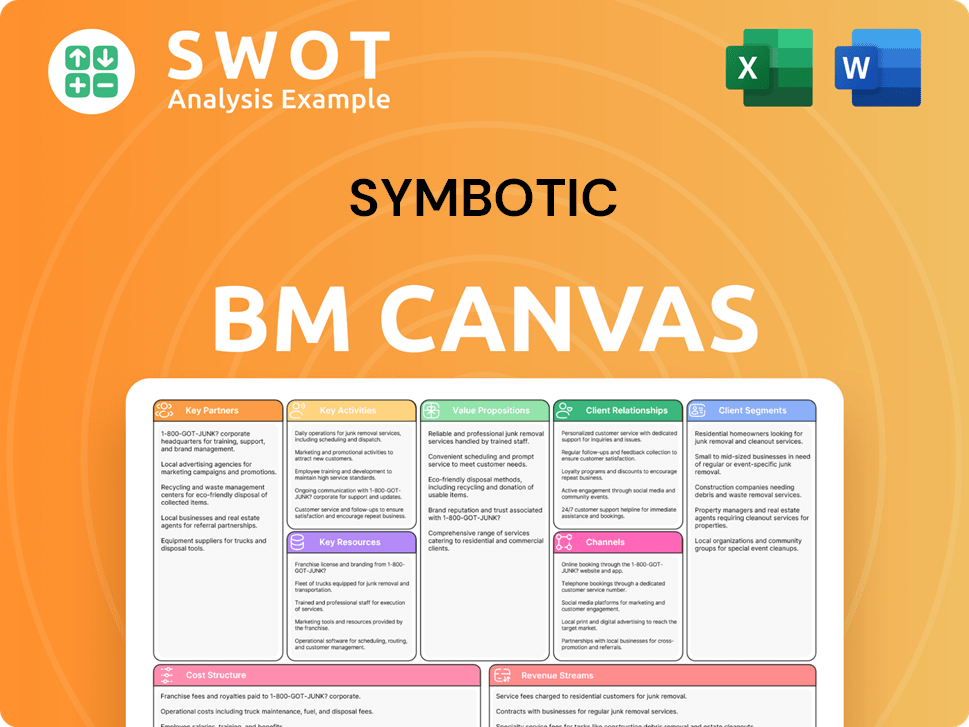
What is the Timeline of Key Events for Symbotic?
The Symbotic company has a rich history marked by innovation and strategic partnerships. Founded in 2007 as CasePick Systems, the company has evolved significantly. From rebranding to Symbotic in 2012 to its public listing in 2022, the company has continually adapted to the demands of the warehouse automation market. Key partnerships with major retailers like Target, Walmart, and Albertsons have fueled its growth, transforming the supply chain landscape. The company's journey reflects its commitment to revolutionizing warehouse operations through advanced robotics and integrated supply chain solutions.
| Year | Key Event |
|---|---|
| 2007 | Founded as CasePick Systems in Wilmington, Massachusetts, by Rick Cohen. |
| 2012 | Rebranded to Symbotic. |
| 2014 | Target adopted Symbotic's technology. |
| 2017 | Began working with Walmart and Albertsons and acquired by C&S Wholesale Grocers. |
| July 2021 | Walmart began introducing Symbotic robots to 25 additional regional distribution centers. |
| December 2021 | Announced plans to go public via a SPAC merger. |
| 2022 | Became a publicly listed company (Nasdaq: SYM). |
| 2023 | Announced a partnership with Walmart to implement robotic automation systems in their distribution centers. |
| Late 2024 | Expanded partnership with Walmart to include two new systems in Mexico under the Walmex brand, marking entry into the Latin American market. |
| November 2024 | Announced restatement of fiscal year 2024 financial results due to revenue recognition errors. |
| January 2025 | Completed the acquisition of Walmart's Advanced Systems and Robotics business and signed a related commercial agreement. |
| February 2025 | Reported Q1 FY2025 revenue of $487 million, up 35% year-over-year. |
| May 2025 | Reported Q2 FY2025 revenue of $550 million, a 40% increase year-over-year, with a net loss of $21 million. |
Symbotic is poised for significant market expansion. Plans include entering new markets, potentially in Europe and Asia. This global growth strategy is crucial for capturing a larger share of the rapidly expanding warehouse automation market, which is projected to reach $95.45 billion in 2025.
The company is heavily investing in research and development. This includes leveraging AI, machine learning, and sensor-driven monitoring. Continuous innovation in robotics and automated warehouse systems will be key to maintaining a competitive edge and offering cutting-edge supply chain solutions.
Deepened collaborations, such as the one with Walmart, are critical. These partnerships are expected to increase Symbotic's future backlog by over $5 billion. This will also expand its addressable market by more than $300 billion in the U.S. alone, driving future revenue growth.
Analysts forecast revenue to increase by 20.84% in 2025, reaching $2.2 billion. The company is working towards consistent profitability, with a narrowed net loss of $21 million in Q2 2025. For Q3 fiscal 2025, revenue is expected to be between $520 million and $540 million.
Symbotic Porter's Five Forces Analysis
- Covers All 5 Competitive Forces in Detail
- Structured for Consultants, Students, and Founders
- 100% Editable in Microsoft Word & Excel
- Instant Digital Download – Use Immediately
- Compatible with Mac & PC – Fully Unlocked
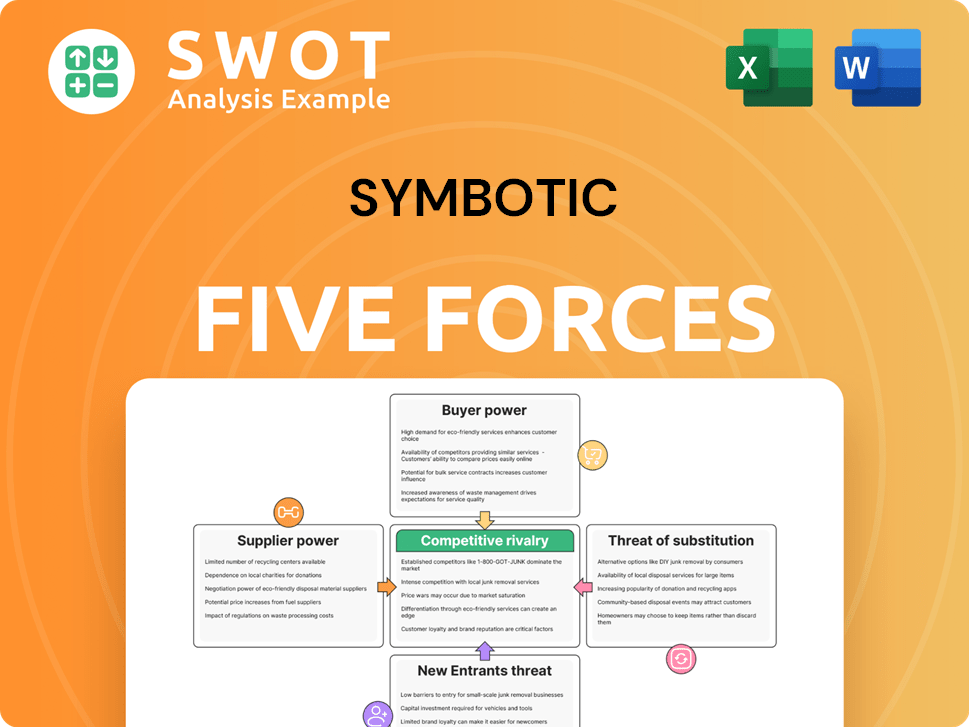
Related Blogs
- What is Competitive Landscape of Symbotic Company?
- What is Growth Strategy and Future Prospects of Symbotic Company?
- How Does Symbotic Company Work?
- What is Sales and Marketing Strategy of Symbotic Company?
- What is Brief History of Symbotic Company?
- Who Owns Symbotic Company?
- What is Customer Demographics and Target Market of Symbotic Company?
Disclaimer
All information, articles, and product details provided on this website are for general informational and educational purposes only. We do not claim any ownership over, nor do we intend to infringe upon, any trademarks, copyrights, logos, brand names, or other intellectual property mentioned or depicted on this site. Such intellectual property remains the property of its respective owners, and any references here are made solely for identification or informational purposes, without implying any affiliation, endorsement, or partnership.
We make no representations or warranties, express or implied, regarding the accuracy, completeness, or suitability of any content or products presented. Nothing on this website should be construed as legal, tax, investment, financial, medical, or other professional advice. In addition, no part of this site—including articles or product references—constitutes a solicitation, recommendation, endorsement, advertisement, or offer to buy or sell any securities, franchises, or other financial instruments, particularly in jurisdictions where such activity would be unlawful.
All content is of a general nature and may not address the specific circumstances of any individual or entity. It is not a substitute for professional advice or services. Any actions you take based on the information provided here are strictly at your own risk. You accept full responsibility for any decisions or outcomes arising from your use of this website and agree to release us from any liability in connection with your use of, or reliance upon, the content or products found herein.